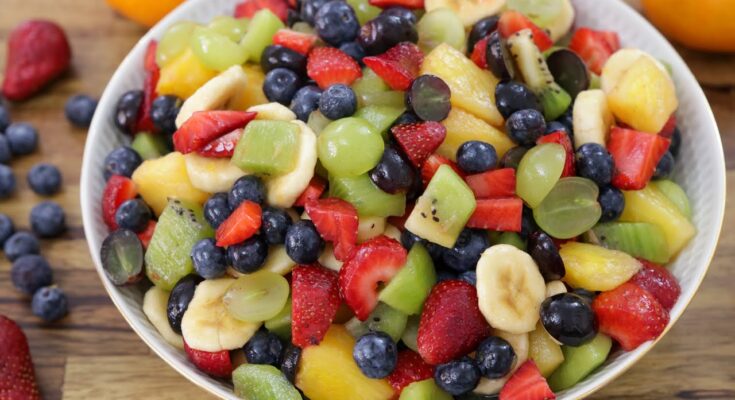Fruit Salad Recipe: Fruit salad is a refreshing, nutritious, and vibrant dish that’s perfect for any time of year. It’s not only simple to make but also versatile, as you can mix and match fruits according to the season, your taste, or whatever you have on hand.
Whether it’s a warm summer day or a festive gathering, fruit salad serves as a light snack, a dessert, or even a breakfast option.
This guide will walk you through each step of creating a delicious, beautifully presented fruit salad that’s both visually appealing and packed with flavor and nutrition.
Ingredients Needed for a Perfect Fruit Salad
Creating the perfect fruit salad starts with gathering fresh, flavorful ingredients. Here’s a list to get you started:
- Basic Fruits: Berries (strawberries, blueberries, blackberries), melons (cantaloupe, watermelon), citrus fruits (oranges, mandarins), grapes, bananas, apples, and pineapples.
- Optional Add-ins: Honey, maple syrup, yogurt, mint leaves, and nuts (like almonds or walnuts) can add extra flavor and texture.
- Ingredient Substitutions: If you can’t find a particular fruit, feel free to substitute with whatever is available, like mango instead of papaya or nectarines instead of peaches.
Using seasonal fruits will yield the best flavors, so don’t hesitate to change the recipe based on the time of year.
Tools Required for Preparing Fruit Salad
Having the right tools makes preparing fruit salad much easier and faster. Here are the essentials:
- Large Mixing Bowl: To hold all the fruits and allow for easy mixing.
- Sharp Knife and Cutting Board: Essential for chopping fruits cleanly and safely.
- Fruit Peeler: Particularly helpful for apples, pears, and any fruits with tougher skins.
- Serving Spoons: To serve the salad without crushing the delicate fruits.
- Optional: A melon baller for aesthetically pleasing melon pieces and a lemon zester for adding zest if you wish.
With these tools, you’ll be ready to prepare and present your fruit salad with ease.
Choosing the Best Fruits for a Salad
A great fruit salad requires a blend of flavors, textures, and colors. Here’s how to select the best fruits:
- Ripe and Fresh Fruits: Select fruits that are in peak condition, as overly ripe fruits may become mushy, while underripe ones won’t be as flavorful.
- Balanced Flavor Profile: Combine sweet fruits like berries and melon with slightly tart options like green apples or citrus for a well-rounded taste.
- Texture Variety: Mix softer fruits (like bananas and berries) with crunchier ones (such as apples or grapes) for an enjoyable texture in every bite.
With these selections, you’ll have a visually appealing and delicious mix of fruits.
Preparation Tips for Fruit Salad
Preparation is key to ensuring your fruit salad is not only tasty but also appealing and fresh. Here’s what you need to keep in mind:
- Wash and Dry Fruits Properly: Dirt and pesticides can linger on fruits, so make sure to wash them thoroughly under running water.
- Cutting Techniques: Aim for bite-sized, uniform pieces so that each spoonful has a balance of flavors and textures.
- Preventing Browning: Fruits like apples and bananas tend to brown after being cut. To prevent this, drizzle a bit of lemon or lime juice over the cut pieces. Not only does it keep the fruits looking fresh, but it also adds a hint of citrus flavor.
With these preparation tips, you’ll ensure your fruit salad stays vibrant and appetizing.
Step-by-Step Fruit Salad Recipe
Step 1: Wash All Fruits Thoroughly
Start by washing all fruits under cool, running water. This is crucial to remove any dirt, pesticides, and bacteria, ensuring your salad is as fresh and clean as possible. For delicate fruits like berries, use a colander to gently rinse them without bruising.
- Use a Vinegar Soak (Optional): A mild vinegar solution (1 part vinegar to 3 parts water) can help remove extra residue, particularly from non-organic fruits.
- Rinse and Dry: After washing, place fruits on a clean cloth or paper towel to dry. This step prevents excess moisture from diluting the natural flavors in your salad.
Washing fruits properly is a small but essential step in preparing a safe and delicious fruit salad.
Step 2: Peel and Chop Fruits into Bite-Sized Pieces
Once the fruits are washed and dried, it’s time to peel and chop them. Here’s how to make sure each piece is perfect:
- Peeling: Remove the skins from fruits like oranges, melons, and bananas. For apples, peeling is optional based on your preference.
- Uniform Chopping: Cut fruits into bite-sized, uniform pieces to ensure every bite has a blend of flavors. For example, dice apples and slice bananas in even rounds.
- Special Techniques for Certain Fruits: If you’re using pineapple, make sure to remove the core and chop it finely. For strawberries, hulling (removing the stem and leaves) before slicing is ideal.
Uniform chopping not only helps with presentation but also makes the salad easier to eat.
Step 3: Combine Fruits in a Large Bowl
Once all your fruits are chopped and prepared, add them to a large mixing bowl. Here’s how to do it:
- Layering Fruits: To keep softer fruits from getting mashed, layer the firmer ones at the bottom. For example, start with grapes, then add melons and apples, and finish with softer fruits like berries and bananas on top.
- Even Mixing: Using a large spoon, gently mix the fruits without pressing too hard. This prevents delicate fruits like raspberries from getting squashed.
Mixing with care will help retain the integrity of each fruit while blending the flavors perfectly.
Step 4: Add Natural Sweeteners and Enhancers
Adding a natural sweetener can elevate the flavor of the fruit salad, especially if some fruits are on the tart side.
- Honey or Maple Syrup: Drizzle a small amount of honey or maple syrup over the fruit. This complements the natural sweetness of the fruits without overpowering them.
- Optional Zest: Adding a little orange or lemon zest brings a bright, citrusy note that pairs well with most fruits.
- Dash of Cinnamon or Nutmeg: For a bit of warmth, sprinkle a tiny amount of cinnamon or nutmeg—just enough to add a hint of spice without masking the fruits’ natural flavors.
These additions are entirely optional but add a unique twist to your salad.
Step 5: Toss the Fruits Gently to Blend Flavors
Once you’ve added any sweeteners or flavor enhancers, gently toss the fruits to combine. This step ensures that every piece is coated evenly with any added ingredients, bringing out the flavors without causing any of the softer fruits to lose their shape.
- Using the Right Tools: Use a large spoon or your hands to carefully toss the fruits. Avoid metal utensils, which can sometimes cause the fruits to brown more quickly.
- Avoid Over-Mixing: Too much tossing can make some fruits mushy, especially softer berries or bananas. A gentle, minimal toss will ensure the salad remains fresh and appetizing.
With a gentle toss, you’ll create a well-balanced fruit salad where each bite bursts with flavor.
Step 6: Adding Optional Ingredients for Extra Flavor
While fruit salad is delicious on its own, a few optional ingredients can add extra flair and texture:
- Fresh Herbs: Add a handful of chopped mint or basil for a refreshing twist. These herbs enhance the salad’s fragrance and give a light, aromatic note that pairs wonderfully with fruits.
- Yogurt or Whipped Cream: To make your salad creamier, mix in a spoonful of yogurt or lightly whipped cream. Greek yogurt is an excellent choice, as its tanginess complements the sweetness of the fruit.
- Crunchy Toppings: Chopped nuts (like almonds, pecans, or walnuts) add a satisfying crunch. You can also add seeds, such as chia or sunflower seeds, for added texture and nutrients.
These optional ingredients allow you to customize your fruit salad, making it more unique and catering to your preferences or dietary needs.
Step 7: Refrigerate Before Serving
Refrigerating the fruit salad before serving can help enhance its flavor and texture. Chilling allows the fruits to absorb the added flavors, making the salad taste even better.
- Optimal Chilling Time: Place the bowl of fruit salad in the fridge for at least 30 minutes. However, avoid refrigerating it for too long (more than a few hours), as some fruits may start to release juice, making the salad soggy.
- Covering the Bowl: Use plastic wrap or a lid to cover the bowl. This prevents the fruits from drying out or absorbing any other odors from the fridge.
Chilling is especially recommended if you’re making the salad for a hot summer day or a party, as it makes the fruit salad refreshing and ready to serve.
Presentation Ideas for Fruit Salad
A well-presented fruit salad is more enticing and adds to the enjoyment of eating it. Here are a few ideas for serving and presenting your fruit salad attractively:
- Serving in Individual Cups or Bowls: Divide the fruit salad into small bowls or glass cups for individual servings. This makes it easier for guests to enjoy and enhances the visual appeal.
- Garnishing with Fresh Mint or Edible Flowers: Garnish with a sprig of mint, basil, or a few edible flowers on top for a beautiful, natural look.
- Using a Pineapple or Melon Bowl: For a tropical feel, consider serving the salad inside a hollowed-out pineapple or melon half. This adds a fun, summery vibe that’s perfect for picnics or parties.
With these presentation ideas, your fruit salad will look as delightful as it tastes.
Tips for Storing Leftover Fruit Salad
If you have leftovers, storing your fruit salad correctly will keep it fresh for as long as possible. Here’s how:
- Use Airtight Containers: Store the salad in an airtight container to prevent exposure to air, which can cause browning and spoilage. Glass containers work well because they don’t absorb odors.
- Storing with Lemon Juice: Drizzle a little extra lemon juice over the salad before sealing the container. The acidity helps keep fruits like apples and bananas from browning.
- Shelf Life: Fresh fruit salad can typically last 1-2 days in the refrigerator. However, some softer fruits, like bananas and berries, may start to soften sooner.
By following these tips, you can extend the life of your fruit salad and enjoy it over multiple days.
Common Variations of Fruit Salad
Fruit salad can be customized endlessly to suit different tastes and occasions. Here are some popular variations:
- Yogurt-Based Fruit Salad: Mix fruits with a generous dollop of Greek or plain yogurt. This version works well for breakfast or as a creamy dessert.
- Tropical Fruit Salad: Use tropical fruits like mango, pineapple, papaya, and coconut for an exotic, island-inspired salad.
- Mixed Berry Salad: Create a salad using only berries (strawberries, blueberries, raspberries, and blackberries). Add a little honey or lime juice for extra flavor.
These variations add variety to your fruit salad experience and can cater to any palate or dietary preference.
Health Benefits of Fruit Salad
Fruit salad isn’t just delicious; it’s packed with nutrients that support overall health:
- High in Vitamins and Minerals: Each fruit adds unique vitamins and minerals. For instance, oranges and berries are rich in vitamin C, while bananas provide potassium.
- Rich in Antioxidants: Berries, grapes, and citrus fruits contain antioxidants that help reduce inflammation and protect cells from damage.
- Great Source of Dietary Fiber: Fiber from fruits like apples, pears, and berries aids digestion, promotes a feeling of fullness, and supports gut health.
Fruit salad is a great way to get a nutrient boost and satisfy your sweet cravings naturally.
FAQs about Fruit Salad Recipe
1. How can I keep my fruit salad from turning brown?
Adding a little lemon or lime juice can prevent browning, especially for fruits like apples, pears, and bananas. The acidity in citrus juice helps maintain the salad’s fresh appearance.
2. Can I use frozen fruits in a fruit salad?
Yes, but keep in mind that frozen fruits may release extra moisture as they thaw, which can make the salad slightly watery. If using frozen fruit, try serving it while partially frozen for a refreshing twist.
3. How far in advance can I make fruit salad?
It’s best to make fruit salad within a few hours of serving to maintain freshness. If preparing in advance, keep firmer fruits separate and add softer ones, like bananas and berries, right before serving.
4. How can I make fruit salad more filling?
Adding protein-rich ingredients like Greek yogurt, cottage cheese, or nuts can make the fruit salad more satisfying and suitable as a light meal.
5. What’s a good way to add protein to fruit salad?
For added protein, mix in nuts, seeds, or a scoop of cottage cheese or yogurt. You can also sprinkle chia seeds or add a handful of almonds for a protein boost.
Conclusion
Making a delicious fruit salad is simple, fun, and incredibly rewarding. By following these steps, you can create a fresh, vibrant salad that bursts with flavor, color, and health benefits. With a mix of seasonal fruits, natural sweeteners, and a few creative touches, your fruit salad will be a hit at any gathering or as a healthy treat for yourself. Enjoy experimenting with different fruits and flavors to make this recipe truly your own.
References
For readers who wish to delve deeper into making the perfect fruit salad, here are some trusted sources that offer further insights and tips. These references validate the information provided and offer additional techniques to enhance your fruit salad experience:
- Food Network’s Guide to Fruit Salads
- Bon Appétit: Creative Fruit Salad Recipes
- Allrecipes: Tips for Fresh Fruit Salads
These links provide recipes, tips, and expert advice to inspire your next fruit salad creation.



